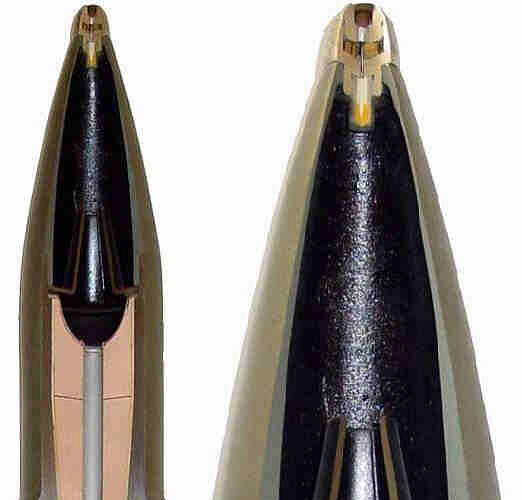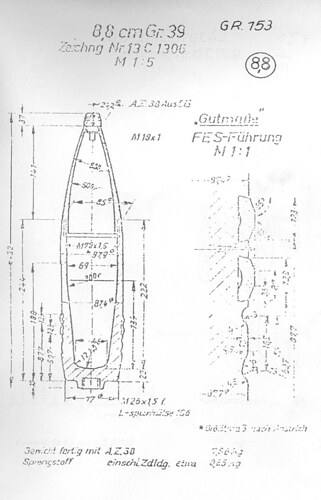I am looking for images of the hollow charge grenades for 75 and 88mm tank guns. if somebody could help…:rolleyes:
Wait…you mean THE panzerknacker needs help finding PICS?! Wow, that’s a first…ok lets see what we can find.
Yeap, pretty embarrasing :D…I had some drawing of those but I ve lost or erased from my Pc.
Here is a cross sectioned Hohlladungsgranate 39 for the 8,8 cm KWK used in Tiger I.
Best Genkideskan
Beautiful, danke schön, if you got the others pages of the ammo please post it. 
No , it are good enough, thanks Wolframmo. 
Hi P.K. Is this round spin stabilized? that was always a no-no, it was feared that the spin would disperse the jetstream. who can enlighten us?
Yes , it was spin stabilized, note in the Genkidescan attachment the word “führungringe” leadin ring or conductive band, obviously the one wich grab the kwk 36 grooves.
I am curious to know whether or not that would affect the formation of the jetstream, very odd indeed.
The most definately yes, just note that the HL 39 of 88mmm pierced 90mm armor…the round used by the rocket launcher Rpzb 54 used less explosive and have the same diameter 8,8 cm, but it defeat 140-150mm armor.
However I think the reasons behind the creation of the Granate 39 Hl is to have a “multipurpose round” , more or less good against armor and more or less good against infantry and soft targets.
considering that, it would be usefull in either roll, maybe not super efficient, but a reasonable trade off, with not having to expend resources to transport, and store and supply two different munitions. (saves room on the trucks for some wine and cigaretts)
Download the manual here
http://rapidshare.com/files/57249780/HDV481-060__MUN._8_8CM-KWK_36__08.01.43.rar.html
Dont overlook that the armour piercing ability of a HL chargedo not depend on range - even at 2500 m it will penetrate 90mm …
I do understand that, velocity isnt an issue with a shaped charge warhead. As long as the safety device in the initiator or fuze has been unlocked, one could walk up to a tank, and smack the warhead on it to fire the thing.(Dont try this at home, ) So all one has to do, is get it to the target.
) So all one has to do, is get it to the target.
The position was how much less effective it would be against armor by being a spin stabilized weapon. A charge of that size should be able to blow through much more armor than that. But as P.K. pointed out, it was intended as a multi use round, so that is understandable, and not a bad idea.

Regarding the effect on jetstream, my guess is that the rotational speed wouldnt have much, if any effect. I could be completely wrong about this of course 
Heres my thinking, if we look at the German 7,5cm PaK40 firing the Gl39 hollowcharge round. The Velocity of the projectile is approximately 600m/s, the rifling length of the barrel is 2.461m. Therefore in 1 second the projectile would rotate 243 times…for round numbers sake, lets call it 250 times.
So if the explosive speed is 1ms, then the projectile, would have rotated, 90degrees, ie 1 quarter of 1 revolution during that time…hardly a significant effect.
So, if we now assume the diameter of the jetstream is 10mm (??) then surely the reduced centripetal force trying to disrupt the jetstream would be miniscule compared to the speed and force of the explosion?
I could of course be completely wrong, but clearly hollowcharge rounds worked…and therefore the jetstream wasn’t disrupted, even if its not the reason i sugguest 
Anyone else have a better theory?
Wolf
Its not that the shaped charge wont work, it just woud lose much of its inherent effectivness. I got this from a Geocities site, and article about Panzerfaust technology.
“Another problem was that if stabilized during the flight by spin, that spin would unfocus the detonation jet stream and hence increase its diameter but lessen its force. Therefore shaped-charge projectiles should not be stabilized during flight by means of spin as is the case with almost any gun bullet or cannon round, but rather had to rely on small fins for some degree of stabilization.The low speed and lack of powerful stabilization make for an inherently rather inaccurate weapon that will deteriorate in accuracy exponentially with range.
Still, because it didn’t require a complicated apparatus to achieve a high-energy muzzle velocity in order to work, the shaped charge was the ideal basis for a cheap, lightweight close-range infantry AT weapon.”
And if you want to get totally confused, this has nothing to do with gyro-diffusion, but is interesting.(comes from Global Security.Org, shaped charge theory.
" Hydrodynamic penetration is a complex mechanism which begins to appear when the strike velocity exceeds a critical value, typically about 1,150m/s for current penetrators against rolled homogenous armor (RHA) targets. Full hydrodynamic behavior does not occur until the strike velocity reaches several kilometers per second, such as occurs with shaped charge munitions. At strike velocities less than about 1,150m/s penetration of metal armor occurs mainly through the mechanism of plastic deformation. A typical penetrator achieves a strike velocity around 1,500m/s to 1,700m/s, depending on range, and therefore target effects generally exhibit both hydrodynamic behaviour and plastic deformation.
A number of models of varying degrees of complexity have been developed to predict long rod penetrator performance. A common feature that emerges from these models is the importance of a high strike velocity to exploit more fully the hydrodynamic penetration mechanism, which, in turn, is further improved by the use of longer penetrators having higher densities relative to the target material density. This is amply supported by experimental work.
Shaped charge is indeed an extraordinary phenomenon that is beyond the scale of normal physics, which explains why its fundamental theoretical mechanism is by no means fully understood.
The shaped charge jet tip reaches 10 kms-l some 40 µs after detonation, giving a cone tip acceleration of about 25 million g. At this acceleration the tip would reach the speed of light, were this possible, in around 1.5 seconds. But of course, it reaches a terminal velocity after only 40 millionths of a second. It is difficult to think of any other terrestrial event as fast as a shaped charge jet tip. The jet tail has a velocity of 2-5 kms-l and so the jet stretches out to a length of about 8 cone diameters (CDs) before particulation occurs. The stretching occurs at a high strain rate, requiring the cone material to have excellent dynamic ductility at temperatures up to about 450°C. On reaching a target, the pressure developed between the jet tip and the forming crater can be as high as 10 Mbar (10 million atmospheres), several times the highest pressure predicted in the Earth’s core.
It is universally agreed that conical liner collapse and target penetration both occur by hydrodynamic flow. However, it has been established by X-ray diffraction that the jet is solid metal and not molten. Additionally, best estimates of jet temperature by incandescence colour suggest a mean value of about 450°C, and copper melts at 1083°C at atmospheric pressure. So the following conundrum is the first confusion: The jet appears to behave like a fluid, and yet it is known to be a solid. One recent theory that would help explain this is that the jet has a molten core but with a solid outer sheath.
The hypervelocity hydrodynamic impact (unlike lower speed KE penetration) results in a mushroom head penetration, such that the hole diameter is larger than the penetrator diameter. The dynamic compressive yield stress of the target is exceeded by a factor of at least one thousand times, so that only the densities of the target and jet materials are important. Both materials flow as if they were fluids and the penetration event can be modelled quite accurately using the Bernoulli equation for incompressible flow to give the well known hydrodynamic penetration equation. "
Download the manual here
Thanks. And there is no doubt, the turning movement did affected the hollow charge.
Regarding a manual this special shell was made for the eastern front.
A tank alone was lost - so the russians placed a platoon on every tank.
This HL shell didnt only stop the tank but sweeps of the infantry off, too.
Beneath the armour piercing ability a hail of fragments and a blast was produced at the impact. A special purpose shell to stop the tank riding russians.
The problem of spreading the jetstream was known but to get a good accuracy a spin stabilized shell was needed.
In late war there are trials with loose driving bands that rotate and have only the task of gas tightened the shell - the shell itself didnt rotate -only the driving band. The stabilizing was made by a long rod with fins at the base of the shell. The war ended befor the ammo couldt be produced but the trials gave good results with a 30 - 50 % higher armour piercing ability and a very good accuracy - smooth bore was used in combat, too with the PAW guns.
( Panzerabwehrwerfer ).



